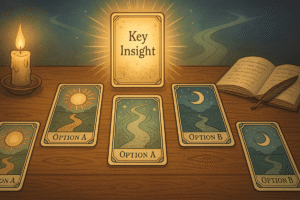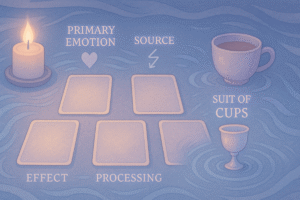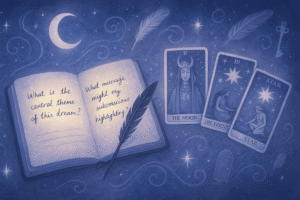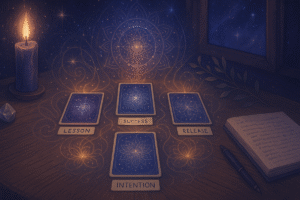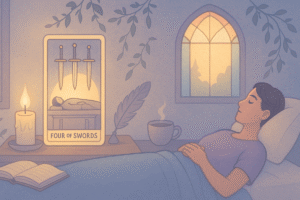Table of Contents
Sometimes a tarot card just doesn’t make sense. You lay it down, stare at it, and feel… nothing. Or maybe you feel too much, and the meaning scatters in different directions. That’s where clarifier cards come in. They’re like asking a follow-up question when the first answer leaves you hanging.
I’ve found that clarifiers aren’t about getting a “better” answer. They’re about getting a fuller picture. Think of them as the card that helps you understand what the original card is really trying to say. It’s a simple technique, but it can transform a confusing reading into something that clicks.
What Exactly Is a Clarifier Card
A clarifier card is an additional card you draw to gain more insight into a card that feels unclear or contradictory. It’s not part of your original spread. You pull it after you’ve already laid out your cards and realized one of them isn’t speaking to you clearly.
The beauty of this approach is its flexibility. You’re not locked into a rigid structure. If a card confuses you, you can ask for clarification. It’s that straightforward.
Some readers use clarifiers constantly. Others only reach for them when they’re genuinely stuck. There’s no universal rule here, which is actually liberating. You develop your own rhythm with it over time.
The clarifier doesn’t replace the original card. Instead, it adds context, depth, or a different angle. Maybe the original card represents the surface of a situation, and the clarifier shows what’s underneath. Or perhaps the first card is the challenge, and the clarifier reveals the hidden resource you have for dealing with it.
When to Reach for a Clarifier Card
Not every confusing card needs a clarifier. Sometimes confusion is part of the message. Sitting with uncertainty can be valuable. But there are specific moments when a clarifier becomes genuinely useful.
If a card appears that seems completely unrelated to your question, that’s a good time. For example, you ask about a career decision, and the Three of Cups appears. At first glance, it might not connect. A clarifier could reveal whether it’s pointing to collaboration, celebration after a decision, or perhaps a reminder not to neglect your social connections during a stressful work period.
Contradictory cards within a spread also call for clarification. Imagine you have the Ten of Cups and the Five of Pentacles sitting next to each other. One speaks to emotional fulfillment, the other to hardship or feeling left out. A clarifier might show you which energy is dominant, or how these two seemingly opposite experiences exist simultaneously in your situation.
Sometimes a card just feels flat. You know the textbook meaning, but it’s not resonating. The energy feels muted or blocked. Drawing a clarifier can help you understand why you’re not connecting with it, or what aspect of that card’s energy is most relevant right now.
I think it’s also worth pulling a clarifier when a card evokes a strong emotional reaction but you can’t articulate why. Your intuition is clearly responding to something. The clarifier can help bridge the gap between that gut feeling and conscious understanding.
How to Draw and Position Your Clarifier
The mechanics are simple, but intention matters. When you recognize you need a clarifier, take a moment. Don’t rush. Formulate your question about the confusing card clearly in your mind.
You might ask something like “What do I need to understand about this card?” or “What is this card really pointing to in my situation?” or “What’s the deeper message here?” The question should be specific to the card you’re clarifying, not a completely new question about your original topic.
Shuffle your deck again, or cut it if you prefer. Some readers shuffle thoroughly, others just cut and draw from the top. Both work. What matters is that you’re creating a small reset, a moment to refocus your energy on this specific inquiry.
Draw one card. Place it directly next to or slightly overlapping the card you’re clarifying. The physical proximity matters, at least symbolically. You’re creating a visual link between the two.
Now look at both cards together. Don’t interpret the clarifier in isolation. The relationship between the two cards is where the insight lives. How do their images interact? Do the figures face each other or turn away? Do the colors harmonize or clash? Are the suits complementary or contrasting?
Reading the Relationship Between Cards
This is where things get interesting. The clarifier and the original card create a dialogue. You’re looking for the thread that connects them, the story they tell together.
Sometimes the clarifier card shares the same suit as the original. This often means you’re being asked to go deeper into that particular element or life area. If you drew the Seven of Swords and your clarifier is the Five of Swords, you’re dealing with layered issues around conflict, strategy, or perhaps dishonesty. The clarifier isn’t changing the subject; it’s zooming in.
When the clarifier is from a different suit, it might be showing you which lens to use. Perhaps your original card is the Eight of Pentacles, representing dedicated work, and your clarifier is the Knight of Cups. This could suggest that your work needs a more creative or emotionally connected approach. Or maybe it’s pointing to a person who will be important to your work situation.
Court cards as clarifiers often represent people, aspects of yourself, or approaches to take. If your confusing card is The Hanged Man and your clarifier is the Queen of Swords, it might indicate that the period of suspension or waiting requires clear thinking and emotional boundaries. Or perhaps someone with Queen of Swords qualities will help you navigate this pause.
Major Arcana clarifiers tend to elevate the importance of the original card or reveal a deeper spiritual or psychological pattern at play. They’re the underlying current. A minor arcana card clarified by a major arcana card is telling you this seemingly small situation connects to a larger life theme or lesson.
Pay attention to the numbers too. A clarifier with the same number as your original card often points to a recurring pattern or theme showing up in multiple areas of your life. Two fives in combination might highlight themes of challenge, change, or instability that you’re experiencing across different contexts.
Common Clarifier Scenarios and What They Mean
Let me walk you through some real examples, because abstract explanations only go so far. These are situations where clarifiers have genuinely helped unlock a reading.
Scenario one: You pull the Tower for a question about a relationship, and you panic because, well, it’s the Tower. But something feels off about the panic. You draw a clarifier and get the Ace of Cups. Suddenly the Tower isn’t about destruction; it’s about the necessary collapse of old emotional patterns to make room for new, authentic connection. The Ace of Cups shows that what’s being destroyed is creating space for something emotionally fulfilling.
Scenario two: The Seven of Pentacles appears for a career question, but you’re not sure if it’s saying “keep going” or “reassess.” Your clarifier is the Four of Swords. Now you have context. The Seven of Pentacles is asking you to pause and rest (Four of Swords) while you evaluate your progress. It’s not about abandoning your work; it’s about taking a strategic break to gain perspective.
Scenario three: You’re confused by the Queen of Wands in a reading about a creative project. Are you supposed to be this queen, or is this someone else? The clarifier is the Two of Wands. This suggests the Queen of Wands energy is about your own confidence and vision moving forward. The Two of Wands connects to planning and future vision, so the Queen here likely represents the bold, charismatic energy you need to embody as you plan your next steps.
Perhaps one more: The Moon appears in a spread about a decision, and you’re unsure if it’s warning against illusion or encouraging you to trust your intuition. Your clarifier is the Hermit. This pairing suggests the Moon is calling you inward, to a period of solitary reflection (The Hermit) where you can sort through what’s real and what’s projected fear. It’s not saying the path is deceptive; it’s saying the answer requires deep, internal contemplation.
Avoiding Clarifier Overload
Here’s something I’ve learned the hard way: you can absolutely overdo clarifiers. I’ve watched readers draw clarifiers for their clarifiers, creating a sprawl of cards that becomes more confusing than the original question.
Set a boundary. One clarifier per card is usually enough. If that clarifier is also confusing, resist the urge to immediately draw another one. Sit with the combination. Write about it. Come back to it later. Sometimes the meaning reveals itself after some time away from the reading.
There’s also the temptation to use clarifiers to avoid messages you don’t like. If every “negative” card gets a clarifier, you might be trying to escape the reading rather than understand it. Be honest with yourself about why you’re reaching for that extra card.
Clarifiers work best when they’re truly about understanding, not about getting a different answer. They’re for depth, not for a do-over.
Integrating Clarifiers Into Your Practice
Once you start using clarifiers, you’ll notice they become a natural part of your reading process. You won’t overthink it. You’ll just know when you need one.
I’d suggest keeping notes on your clarifier pulls, especially in the beginning. Write down the original card, why it confused you, what clarifier you drew, and what the combination revealed. Over time, you’ll notice patterns in how certain cards clarify others in your readings. This becomes part of your unique relationship with your deck.
Some spreads lend themselves to clarifiers more than others. Complex spreads with many cards might not need them because the other cards in the spread often clarify each other naturally. Simple one or three card spreads sometimes benefit more from clarifiers because there’s less surrounding context.
You might also find that certain positions in spreads consistently need clarification. Maybe you always struggle with “advice” or “outcome” positions. That’s valuable information about where your reading style needs support.
The Bigger Picture
Using clarifier cards is really about building a conversation with your tarot practice. It acknowledges that tarot isn’t about rigid, unchangeable meanings but about exploration and dialogue. The cards offer perspectives, and clarifiers help you understand which perspective is most relevant right now.
This technique also reinforces personal agency in readings. You’re not passively receiving messages; you’re actively engaging, asking questions, seeking understanding. That shifts the entire dynamic from fortune telling to introspection.
What I appreciate most about clarifiers is how they train you to look deeper. After using them regularly, you start noticing the subtle layers in cards even without drawing an extra one. Your interpretive skills sharpen. You become more comfortable with nuance and complexity.
They also make tarot more accessible, honestly. When you know you can ask for clarification, the pressure to immediately understand every card decreases. You give yourself permission to not know, and that’s when the real insights often come through.
So next time a card leaves you puzzled, don’t just sit there stuck. Ask it to explain itself. Draw that clarifier. See what conversation unfolds.


